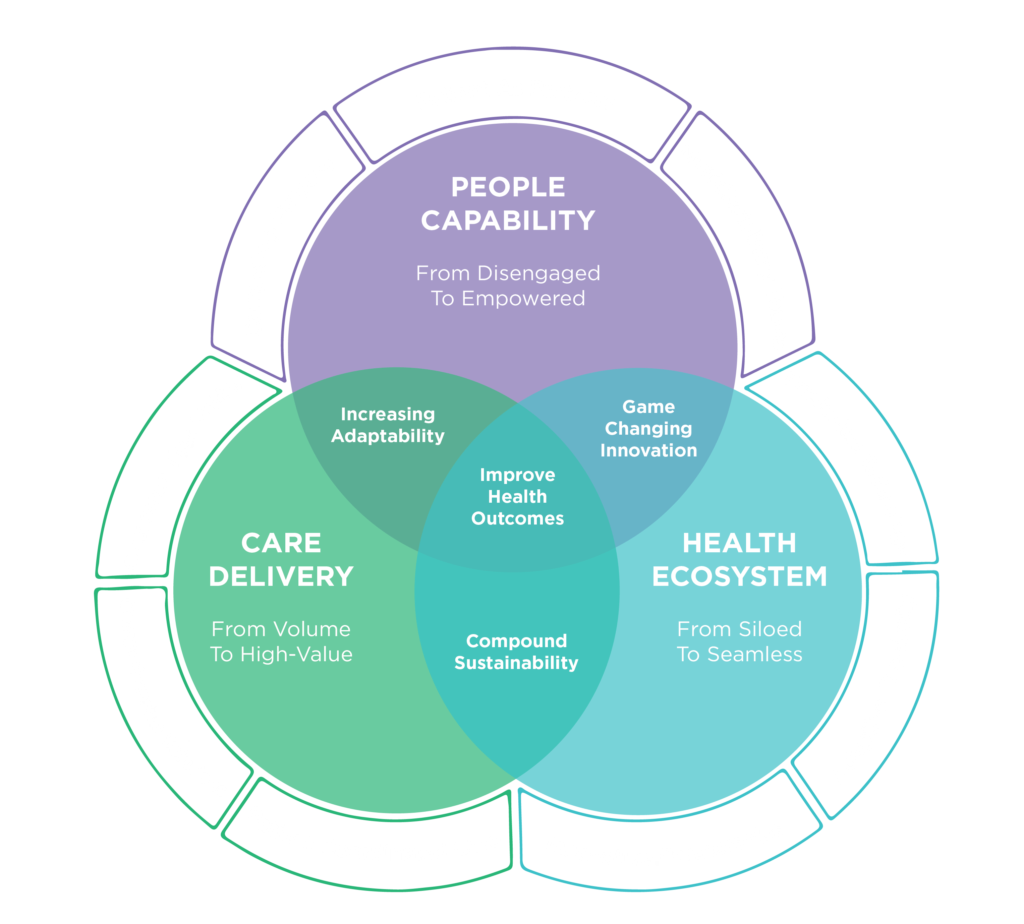What Does
Patient-Centred
Care Look Like?
Beyond Patient-Centred: Embracing Consumer-Driven Health Partnerships
In today’s fast-paced, consumer-led world and fuelled by the COVID-19 pandemic where patients were educated to take responsibility for their own health, Australians are now stepping up to become a “partner” in their own health.
At Experience 360, we believe that the future of Australian healthcare looks beyond becoming simply “patient-centred” in your approach and embraces a new Patient Partnership model of healthcare where patients are driving their own healthcare experiences, rather than accepting the paternal, healthcare professional-led approach which has been traditionally seen in most Australian services.
In our experience working with progressive healthcare organisations who are evolving towards this Patient Partnership model, we typically see them move through three key phases:
A one-way relationship where the patient and their family is a passive participant and the healthcare professional is the authority that ‘knows best’ and directs the healthcare decisions. The patient is not involved in communication between healthcare providers.
The patient is recognised as having vital knowledge of living with a disease or condition that can be important to consider in the care process. Patients and their families are more involved in communication and feel more empowered to express opinions, share information and make decisions around their own care to help improve their own health outcomes.
In a true patient partnership model, the patient is considered a full member of the care team and their knowledge and decisions are valued and respected throughout the care process. All members of the care team – including the patient, their family or carers and all involved healthcare professionals – work and communicate together in an effort to achieve the agreed health outcome.
What's involved in moving to a patient centred approach?
Lorem ipsum dolor sit amet, consectetur adipiscing elit. Ut elit tellus, luctus nec ullamcorper mattis, pulvinar dapibus leo.
- People Capacity from disengaged to empower staff patients and community.
- Health Ecosystem from soiled to seamlessly integrated.
- Care Delivery from volume to high-values health care.

Measuring Health Outcomes: PREMs and PROMs
So how do you actually go about measuring patient health outcomes?
Outcomes-based or Value-based healthcare outcomes are measured using both Patient Report Outcome Measures (known as PROMs) and Patient Reported Experience Measures (PREMs).
PROMs are questionnaires that patients complete that focus on their own view of the outcomes relating to their health (ie: “How do you feel?”).
By implementing, endorsed evidence-based standard data sets, PROMs may be tailored to a specific condition, a particular population (e.g: children) or to the whole population.
PROM surveys generally include questions around symptoms, side effects and the patient’s quality of life. The insights from PROMs allow patient outcomes from their treatment and/or consultations to be measured and benchmarked across patient cohorts or at the practice, regional or national levels.
PREMs are questionnaires which ask patients and carers about their experiences with the healthcare service they have interacted with, (ie: “What did you think of the service you received?”).
These surveys can include measures related to the waiting times experienced, the physical environment of the practice, the interactions with health care professionals and administrative staff, the quality of information received, right through to the level of involvement they had in decision making around their care.
The insights from both these measures help the practice and its healthcare professionals identify their strengths, weaknesses and uncover important areas of improvement along the patient journey.

The Kings's Fund
The King’s Fund is a charity that seeks to understand how the health system in the UK can be improved.
The King’s Fund Point of Care program aims to transform patients’ experience of care in hospital by enabling healthcare staff to deliver the quality of care they would want for themselves and their own families. The King’s Fund works with patients and their families, staff and hospital boards to research, test and share new approaches to improving patients’ experience. Seeing the Person in the Patient: Point of Care Review Paper considered current debates and dilemmas in relation to patients’ experience of care in acute hospitals in the UK.
Based on this research, The King’s Fund developed a framework to analyse the factors that affect patients’ experience at four levels: individual interactions with staff members; the ‘clinical micro-system’ of the team, unit or department; the hospital; and the wider healthcare system, including NHS priorities.

What progress has been made towards adopting value based healthcare in Australia?
How do I measure my outcomes?
- VBHC outcomes are measured using both Patient Reported Outcome Measures (PROMs) and Patient Reported Experience Measures (PREMs).
- PROMs focus on the patient’s view of their own health and this feedback is gathered using a variety of generic or disease/condition specific survey tools. This might include factors like the quality of life they experience following treatment, the types of symptoms experienced and types of distress they might suffer. These results allow patient outcomes from their treatment and/or consultations to be tracked and benchmarked across patient cohorts at the practice, state and federal level.
- PREMs focus on the patient’s experience with the health care and service they have received. These can include measures like the level of involvement they had in decision making, the quality of the communication and information they received, complimentary services offered, right through to waiting times and they physical environment of the practice.
- Together these two measurements provide vital feedback to health services and their health care professionals on their strengths and areas for improvement.
- ICHOM provides support and guidance to healthcare providers world-wide on how to measure outcomes in their own organisations and where standard sets of PROMs and PREMs have already been developed, can provide access to these for use in their organisation. By creating a standardized list of the outcomes based on the patient’s priorities along with instruments and time points for measurement, we can ensure the patient remains at the centre of their care. Through the implementation of these Standard Sets, you can begin to measure, analyze and improve outcomes achieved in the delivery of care. We are continually reviewing our published Standard Sets.

Contact Us To Start Your Patient-Care Journey Today.

Experience 360 - How We Help
Understanding Patient-Centred Care
What is Patient-Centred Care?
Learn More...
Patient-Centred Care in Practice
What Does Patient-Centred Care Look Like?
Learn More...
Getting Started With Patient-Centred Care
How Do I Get Started With Patient-Centred Care?
Learn More...
Patient Journey Mapping
What is Patient Journey Mapping?
Learn More...
Addressing Patient Reviews and Complaints
Patient Reviews and Complaints: What Do I Do?
Learn More...

